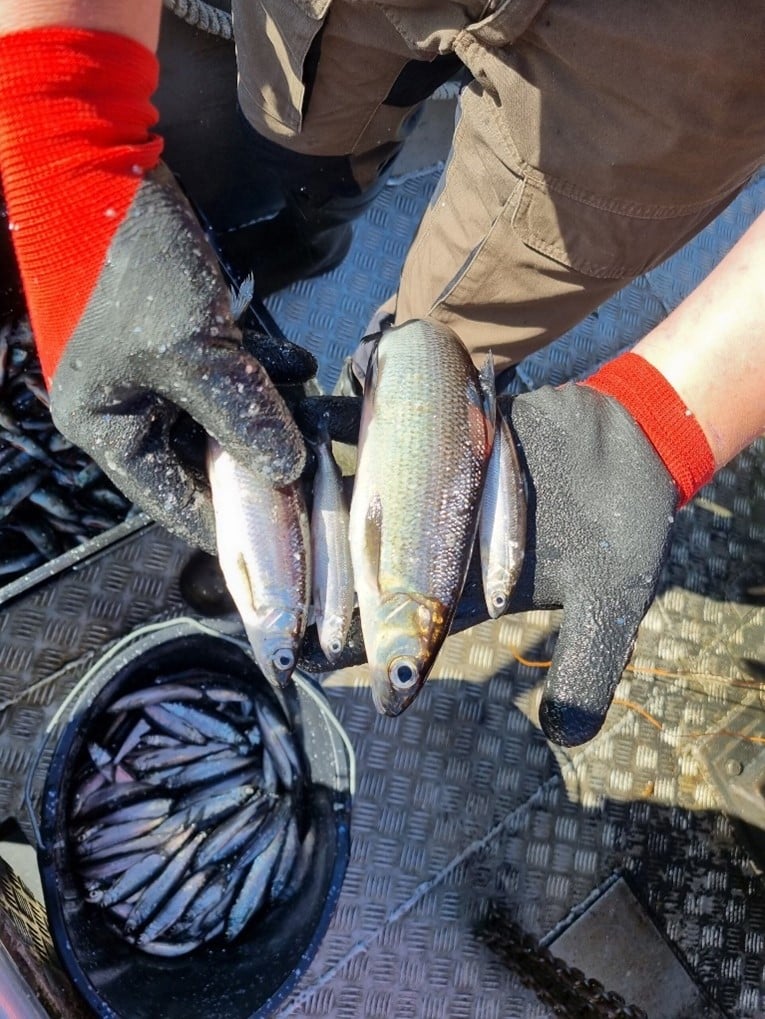The Southern Saimaa and Vuoksi fisheries monitoring programme has been in operation to its current extent since 2001. The program aims to collect data on the structure of fish populations and fishing activities, both in industrial impact areas and in unaffected areas, particularly focusing on key species such as vendace, whitefish and crayfish. A new program has been approved for the years 2022–2026. Fisheries monitoring includes experimental trawling, seine netting, and electric fishing. Crayfish populations are monitored through experimental trapping.
Experimental trawling – an important part of fisheries monitoring
In the autumn of 2024, three experimental trawlings were conducted off the coast of the Joutseno mill. The purpose of these trawlings is to ensure the comparability of results across different years, so they are always performed in the same way, from the same location, and at the same times.
 This autumn's experimental trawlings were managed by Saimaa Fish entrepreneurs Paavo Törrönen and Markku Törrönen, with fishery research conducted by local fish and aquatic researcher Aarno Karels. Tiia Finér, Development Manager at Joutseno pulp mill, also participated in the experimental trawlings. During the trawling, nets are lifted, the catch is collected, sorted by fish species, weighed and representative samples of juvenile vendace and vendace are taken separately. From the representative sample, the length is measured, and age is determined from the scales. Whitefish, vendace, perch, and pike are collected in this year's monitoring program for further studies on odour, taste, and contaminant substances.
This autumn's experimental trawlings were managed by Saimaa Fish entrepreneurs Paavo Törrönen and Markku Törrönen, with fishery research conducted by local fish and aquatic researcher Aarno Karels. Tiia Finér, Development Manager at Joutseno pulp mill, also participated in the experimental trawlings. During the trawling, nets are lifted, the catch is collected, sorted by fish species, weighed and representative samples of juvenile vendace and vendace are taken separately. From the representative sample, the length is measured, and age is determined from the scales. Whitefish, vendace, perch, and pike are collected in this year's monitoring program for further studies on odour, taste, and contaminant substances.
Results of the experimental trawling
- The first trawl near Kätkytsaari brought in 37 kilograms of fish, mainly vendace, with some whitefish as well.
- The second trawl from Pulpinselkä yielded 14 kilograms of catch, consisting of vendace, a few perches, and a trout.
- The third trawl from the Honkalahti area had a smaller catch, primarily consisting of perch.
 According to the 2023 experimental trawling results, vendace make up 90% of the fish species in South Saimaa. Markku and Paavo commented that the condition of the South Saimaa water system is good and has improved over the years.
According to the 2023 experimental trawling results, vendace make up 90% of the fish species in South Saimaa. Markku and Paavo commented that the condition of the South Saimaa water system is good and has improved over the years.
This is also supported by the results of the fisheries experimental trawling; the proportion of fish preferring eutrophic waters, such as bream, perch, and smelt, has decreased over the years, and the vendace population has strengthened and grown.
Continuous commitment to environmental well-being
Fisheries monitoring is part of Metsä Fibre's broader commitment to environmental well-being. Comprehensive environmental monitoring enables effective measures to improve the condition of water bodies and protect fish populations. In addition to its own emission monitoring, the Joutseno pulp mill also finances air quality monitoring.
"We thank our partners and the local community for their contribution and continue to work together towards a cleaner environment and a more sustainable future," concludes Tiia Finér, Development Manager at Joutseno pulp mill.

